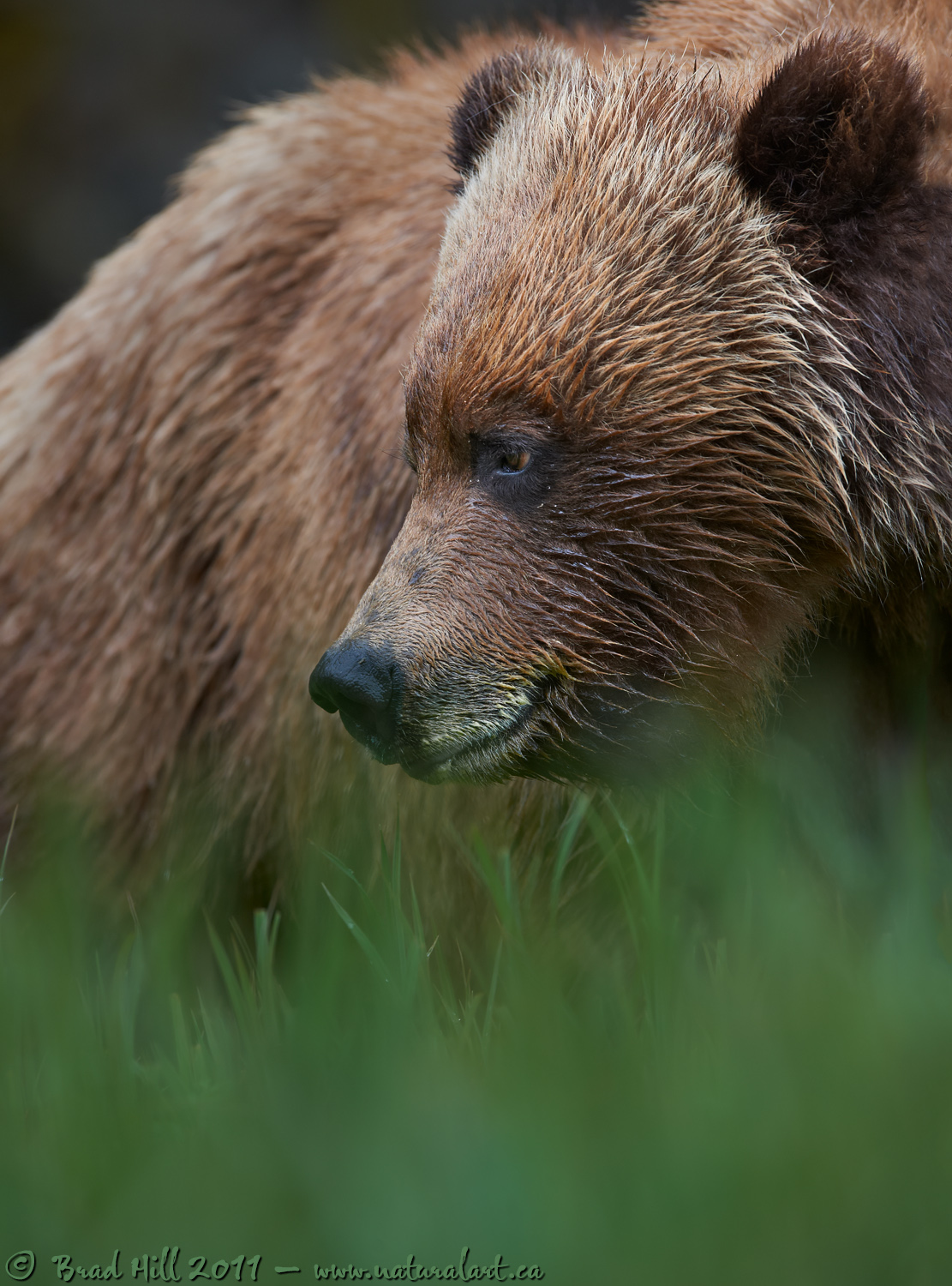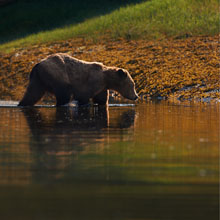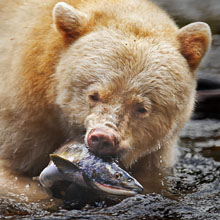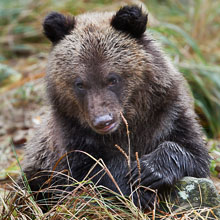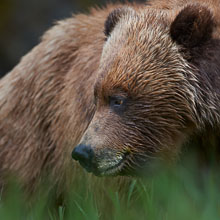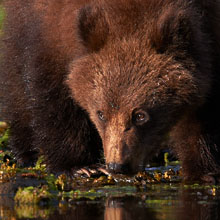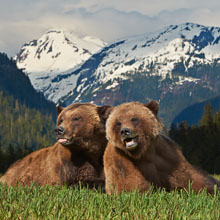Availability: Undetermined - Enquiries?
In the Field
Drip Dry. Khutzeymateen Inlet (Great Bear Rainforest), BC, Canada. May 26, 2011.
If you're into photographing wildlife ONLY when they're dry, you probably shouldn't go shooting in the Great Bear Rainforest! Me - I like shooting wildlife in damp/wet conditions - I think it adds mood and reality to the images and you get a feel for what wildlife really has to endure on a day-to-day basis. And, you get great colour and manageable contrast, especially if your wet animals are accompanied by overcast skies. I've been told that you'll rarely have enough contrast to "pull" good image detail in rainy conditions. Hmmm. I guess I didn't know that and blew getting detail on this shot! But check out the large version of this image if you think it's lacking detail - and the full res version shows WAY more detail than this. Good thing I didn't KNOW to pass on shooting in the rain!
I shot this image with what is becoming my favourite "go-to" lens for wildlife - a 400mm f2.8 prime. Of course, compared to a zoom you lose some flexibility in framing and composition, but the lens offers the type of contrast (in both colour and the in-focus vs. out-of-focus zones) that I like. Given that I gravitate towards scenes with some form of visual contrast in them (light-dark "standard" contrast or colour contrast or sweet bokeh with strong differences in tack sharp in-focus zones and buttery smooth out-of-focus zones) I suppose that's no surprise! In this image I intentionally shot directly through grass to produce the soft, smooth look in the bottom of the image to contrast with (and enhance) the sharp regions on the bear's face.
One last comment: Like most serious nature photographers I have almost as much invested in quality outdoor wear as I do in camera gear. When I see any animal enduring a huge range of harsh conditions with what appears to be no discomfort, I'm always left wondering why someone can't come up with a great Dog-tex (or Bear-tex) line of clothing that works in ALL conditions - from steamy hot jungles through to frigid arctic tundra. Hell, I'd pay premium bucks for the "drip-dry" clothing our furry (or feathered) friends have!
ADDITIONAL NOTES:
1. This image - in all resolutions - is protected by copyright. I'm fine with personal uses of them (including use as desktop backgrounds or screensavers on your own computer), but unauthorized commercial use of the image is prohibited by law. Thanks in advance for respecting my copyright!
2. This image was captured during one of my two spring "Grizzlies of the Khutzeymateen" photo tours in May/June of 2011. Each year I offer trips into two different parts of the Great Bear Rainforest as well as one to photograph aquatic mammals and oceanscapes near the northern tip of Vancouver Island. And, in selected years, I also offer photo tours to locations to capture other highly sought-after subjects, such as various boreal owl species and wildlife of Canada's Arctic. Details about these trips can be found on the Photo Tours page of this website.
3. Like all wildlife photographs on this website, this image was captured following the strict ethical guidelines described in The Wildlife FIRST! Principles of Photographer Conduct. I encourage all wildlife photographers to always put the welfare of their subjects above the value of their photographs.
Behind the Camera
Drip Dry. Khutzeymateen Inlet (Great Bear Rainforest), BC, Canada. May 26, 2011.
Digital Capture; RAW 14-bit format; ISO 320.
Nikon D3s with Nikkor 400mm f2.8 VR lens. Hand-held from floating Zodiac inflatable boat (VR on and in normal mode).
1/250s @ f5.6; no compensation from matrix-metered exposure setting.
At the Computer
Drip Dry. Khutzeymateen Inlet (Great Bear Rainforest), BC, Canada. May 26, 2011.
RAW Conversion to 16-bit TIFF, including first-pass/capture sharpening using Phase One's Capture One Pro 6. Three raw conversions varying in exposure settings over a 1.8 stop range (-0.9 stops from original capture exposure setting to +0.9 stops from capture settings).
Further digital corrections on 16-bit TIFF file using Adobe's Photoshop CS5. Photoshop adjustments including blending of 3 exposure versions, selective exposure and tone curve adjustment, and selective sharpening for web output. About 100 pixels added to entire right side of the frame (yep, framed the original a little too tight to the ear!).
Conservation
Drip Dry. Khutzeymateen Inlet (Great Bear Rainforest), BC, Canada. May 26, 2011.
Ten percent of the revenue generated by this image will be donated to Raincoast*.
Species Status in Canada**: Special Concern (May 2002).
While Grizzly Bears (Ursus arctos) are not technically listed as "Endangered" in Canada, they have been extirpated from most of their historical range. Grizzly Bears are far more sensitive to intrusion/disturbance in their habitat than are Black Bears and are being increasingly forced into marginal habitat by human encroachment. The Great Bear Rainforest along the central and northern coast of British Columbia is one of the last strongholds of the Grizzly Bear in Canada, and even this population is coming under increasing pressure.
On December 18, 2017 the government of British Columbia banned grizzly hunting across the entire province. This major conservation victory came after decades of tireless work by many dedicated conservationists and ecologists and, most importantly, it reflects the opinion of the vast majority of British Columbians. And, it means that AT LEAST while the current government remains in power grizzlies are finally "safe" in British Columbia.
Now that we've at least temporarily won the battle to save grizzlies in BC, it's time to re-focus our efforts toward protecting ALL of BC's carnivores, including Gray Wolves, Black Bears, Cougars, Wolverines, and more! Simply put, there are no ecological, economic, or ethical arguments supporting the trophy hunting of carnivores.
In a great first step towards ending the hunting of carnivores throughout BC the Raincoast Conservation Foundation has developed a program designed to protect ALL carnivores within the Great Bear Rainforest. Details about this program can be found on this page on Raincoast's website. Check it out and, better yet, make a donation to help Raincoast purchase the remaining commercial hunting tenures in the Great Bear!
*The Raincoast Conservation Society (and Foundation) is an effective and efficient organization that has been fighting for protection of this unique habitat. If you are looking for a meaningful way to contribute to the conservation of this amazing ecosystem, Raincoast will provide maximal "bang" for your conservation dollars.
**as determined by COSEWIC: The Committee on the Status of Endangered Wildlife in Canada












